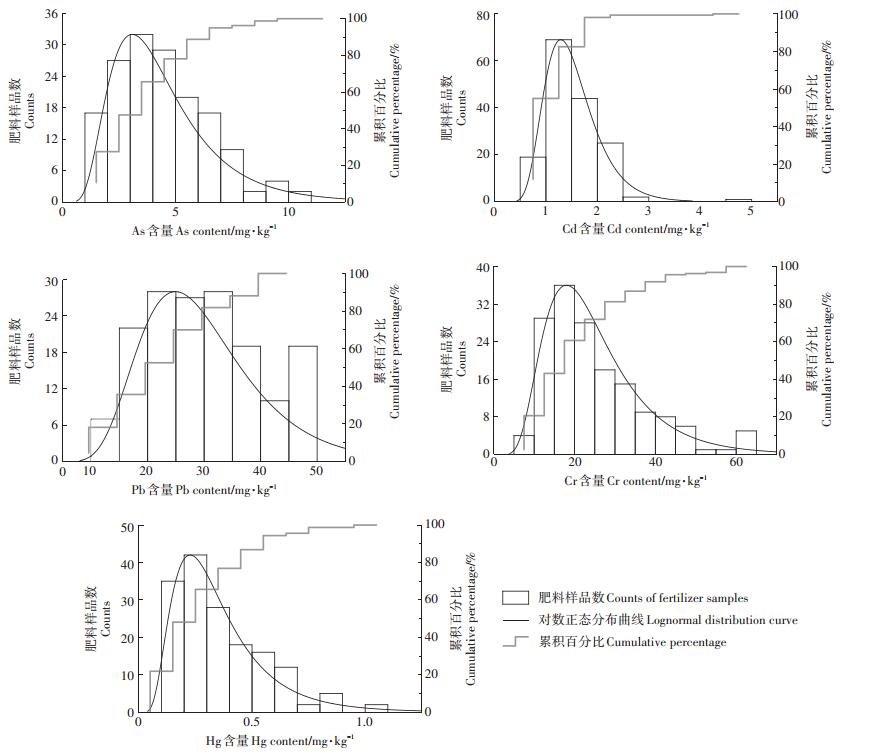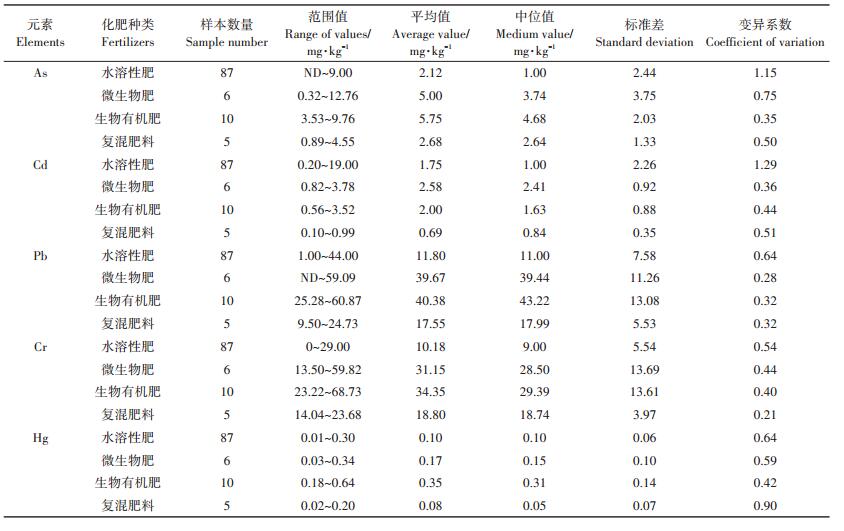随着当今工业生产和农业资源的开发,为了提高和改善土壤生产力,大量肥料和农药等农业投入品被生产和过度使用,由重金属超标所引发的食品安全问题愈发严重。据调查,我国耕地土壤污染点位超标率达到19.4%,其中Cd、As、Hg、Pb等重金属的污染最为严重[1],每年因重金属污染造成的粮食减产超1000万t,而受到重金属污染的农作物超1200万t,经济损失超200亿元[2]。研究表明,土壤中含有的重金属有多种来源,例如土壤母质和化学肥料、农药残留、工厂废水、固体垃圾等污染[3-7]。在诸多的污染来源中,一个非常重要的因素就是农田施用的肥料重金属元素超标。肥料中Cd、Hg、As、Pb、Cr等重金属元素对土壤造成的污染相当严重,这些重金属元素伴随肥料进入土壤中,一方面被植物吸收转运,通过食物链进入人类饭桌,对人们的身体健康构成威胁,造成贫血症、消化不良、神经系统失调以及肾功能损伤等一系列疾病[8-9]。诸如湖南的“镉大米”事件,以及日本发生的“水俣病”“痛痛病”等重金属污染事件,都引起了社会对重金属污染问题的强烈关注;另一方面,残留在土壤中的重金属还能直接或间接影响土壤微环境[10-11]。有研究发现,土壤中的重金属会导致土壤微环境发生紊乱,使得无法适应环境的微生物比例减少,适应环境的微生物大量繁殖[12-13]。因此,肥料作为土壤重金属的重要来源之一,必须使其重金属含量在可接受水平以内,以保证土壤不受污染。
国家要发展,农业是基础,而肥料对于农业生态系统的可持续发展至关重要[14]。有机肥所含营养丰富,长期施用可以增强土壤肥力、改善土壤理化性质、优化土壤微生物群落结构,是生产中十分重要且常用的肥料[15-16]。相关研究表明,有机肥的施加可以增加作物中重金属的富集量,其富集量的多少与有机肥施用的剂量、种类等密切相关[17]。焦璐琛等[18]研究显示,长期施用猪粪能够显著提高土壤中Cd、Cu、Zn的含量,且施用新鲜猪粪的土壤重金属含量比施用腐熟猪粪高。当今国内市场中,肥料的种类不断增多,肥料的生产工艺不同造成其重金属含量差异显著[19],质量无法保证。所以,对市场上售卖的肥料重金属含量进行分析研究显得尤为重要。闫湘等[20]测定了全国不同地区5种水溶性肥料的重金属含量,发现As、Pb、Cd、Cr、Hg 5种重金属均存在超标情况,其中Cd的超标率最高,个别样品的Cd含量达到限量标准值的数十倍,最高为4953 mg·kg-1。Yang等[21]收集了我国212个堆肥样品进行重金属的测定,结果表明As的超标率达到13.7%,Cd的超标率达到2.4%。由此可见,部分肥料中重金属超标的情况不容乐观。迄今为止,针对菜田肥料的重金属研究较少,特别是对多种肥料重金属的综合对比研究更加薄弱。因此综合研究多种典型肥料重金属含量,同时评价肥料重金属对环境的污染程度,对有效减少重金属进入土壤,提高农作物产量、质量,以及防止农田环境污染意义重大。
为保障农产品安全,厘清我国北方菜田常用肥料的重金属含量水平,本研究采集了有机肥、水溶性肥、微生物肥、生物有机肥及复混肥料共5种典型肥料,测定了As、Pb、Cd、Cr、Hg 5种元素的含量并分析肥料中重金属的超标情况,对肥料重金属的污染情况进行评价,以期为我国农业生产、污染防治以及食品健康等方面提供进一步的依据和保障。
1 材料与方法 1.1 肥料样品的采集供试肥料采自我国北方典型的蔬菜基地——山东省寿光市。对全市各地区的肥料售卖情况进行全面调查后,依据寿光市肥料供销点的分布情况,利用不等概率随机样点布设原则,在各大化肥供销点对不同的化肥种类、品牌、生产厂地等进行逐一抽样,随机购买了市场上销售量较大及市面常见的品牌肥料样品共268个,其中包括有机肥160个、水溶性肥87个、生物有机肥10个、微生物肥6个以及复混肥料5个。
1.2 肥料样品的处理本研究参照《肥料汞、砷、镉、铅、铬含量的测定》(NY/T 1978—2010)对样品进行处理,采用原子吸收分光光度计测定了Pb、Cd、Cr、Hg和As 5种重金属的含量。具体方法如下:称取约0.50 g的肥料样品研磨过筛,滴加去离子水湿润后加入10 mL HCl进行冷消化过夜,之后置于电热板上加热约1 h,然后加入HNO3、HClO4、HF继续加热。待坩埚内物质呈透明可流动的膏状物后冷却片刻,使用去离子水冲洗,然后向其中加入1 mL HNO3,再将溶液移入50 mL的容量瓶定容,用定量慢速滤纸进行过滤后转入离心管待测。每种样品做3次重复,取其测定结果的平均值,同时进行空白对照试验。
1.3 重金属污染的评价方法采用单因子污染指数和综合污染指数法对5种肥料中重金属进行污染评价。单因子污染指数算法为:

|
式中:Pi为重金属i的单因子污染指数;Ci为重金属i的平均浓度值,mg·kg-1;Si为重金属i相应的限量标准,mg·kg-1(表 1)。
|
|
表 1 肥料中重金属限量标准(mg·kg-1) Table 1 Standard limit value of heavy metal content in fertilizer(mg·kg-1) |
综合污染指数法(内梅罗综合污染指数法)算法为:

|
式中:P综为内梅罗综合污染指数;(Ci/Si)max为重金属i的单因子污染指数的最大值;(Ci/Si)avg为重金属i的单因子污染指数的平均值。
1.4 肥料中Hg、As、Cd、Pb、Cr的限量标准5种肥料的重金属标准限值见表 1。
1.5 数据处理实验数据采用SPSS 22.0软件中K-S检验和P-P图的对数正态分布检验对各重金属含量进行分析,用Origin 2017进行制图。
2 结果与分析 2.1 有机肥的重金属含量分析有机肥重金属的含量利用SPSS中P-P图进行对数正态分布假设检验,数据各点在图中近似成一条直线,可初步判定数据符合对数正态分布,再将实验数据经对数转化后进行非参数检验(Kolmogorov - Smirnov检验),得出P≥0.05,进一步证实有机肥的重金属含量服从对数正态分布[22-23]。因此,使用几何平均值(GM)与几何标准差(GSD)来表示实验数据的整体趋向以及离散水平更为准确。为精确实验结果,每种重金属元素的含量使用95%的置信区间,其浓度上下限可通过GM×GSD2和GM/GSD2求得,参考重金属元素的上基线浓度可以更为合理地反映有机肥料中重金属元素的整体超标情况[24]。
根据表 2可看出,有机肥中As、Cd、Pb、Cr、Hg 5种元素的几何平均值分别为3.96、1.44、28.16、22.42、0.31 mg·kg-1,均低于国家对于肥料重金属含量的限定标准。Pb和Cr的几何平均值分别达到了28.16 mg·kg-1和22.42 mg·kg-1,明显高于其他3种元素,Hg最低,为0.31 mg·kg-1。
|
|
表 2 有机肥料重金属含量分析 Table 2 Analysis of heavy metal content in organic fertilizers |
由图 1可知,有机肥中Cd的含量在1~2 mg·kg-1区间内占比最高,80%以上的样品Cd含量小于2 mg· kg-1,只有1个样品的Cd含量大于3 mg·kg-1,为4.54 mg·kg-1。As含量在2~5 mg·kg-1区间内的样品数最多,占总样品数的一半以上,含量超过10 mg·kg-1的样品仅有2个,最大值为10.99 mg·kg-1,未超过国家限定标准。Pb含量在15~35 mg·kg-1区间内的样品数量占总样品数的一半以上,含量在45~50 mg·kg-1区间内样品约占总样品数的12%,说明部分样品的Pb含量仅处于达标水平。Cr含量在15~35 mg·kg-1区间范围内分布较多,占总样品数的60%以上,说明大部分样品Cr的含量远低于国家标准,Cr含量在60~65 mg· kg-1的样品仅为总样品数的3%,最大值为63.70 mg· kg-1,所测样品均未超过国家标准。Hg含量最小值为0.11 mg·kg-1,主要集中在0.1~0.4 mg·kg-1区间范围内,超过1 mg·kg-1的样品仅有2个,其含量均在国家标准以内。

|
图 1 有机肥料样品中重金属含量分布直方图 Figure 1 Histogram of heavy metal content distribution in organic fertilizer samples |
通过P-P图与K-S检验得知,水溶性肥、微生物肥、生物有机肥、复混肥料样品中重金属的含量均不符合对数正态分布,故直接用算术平均值来代表整个数据的整体趋势和分布特征更为精确,以上4种肥料的数据分析如表 3所示。
|
|
表 3 其他肥料重金属含量分析 Table 3 Analysis of heavy metal content in other fertilizers |
由表 3可知,此次调查的肥料样品中5种重金属元素含量的算数平均值基本都低于我国肥料中重金属的标准限定值,但也存在部分肥料重金属元素超标的情况。本研究中的肥料样品全部含有Cr、Cd、Pb、As、Hg等重金属元素。具体分析各样品重金属的算数平均值可知,重金属在化肥中的平均含量除Hg表现为生物有机肥 > 微生物肥 > 水溶性肥 > 复混肥料,Cd表现为微生物肥 > 生物有机肥 > 水溶性肥 > 复混肥料,其他3种重金属均呈现生物有机肥 > 微生物肥 > 复混肥料 > 水溶性肥的规律。Hg、As、Cd相对其他2种重金属元素在4种肥料中的含量较少,Pb、Cr的含量较大,相同实验条件下,后者的含量是前者的数倍,如Hg在4种肥料中含量范围为0.01~0.64 mg·kg-1,而生物有机肥和微生物肥中Pb含量平均值分别高达40.38 mg·kg-1和39.67 mg·kg-1。
通过观察4种肥料中5种重金属元素的变异系数可知,同一重金属元素在不同肥料产品中的含量差异较大。变异系数以0.1和1为临界点,小于0.1表现为弱变异性,大于1表现为强变异性,二者之间表现为中等变异性。从变异系数来看,只有水溶性肥中的As和Cd为强变异性,其余均为中等变异性。
2.3 重金属含量超标情况由于不同肥料其生产原料或加工方式的不同,国家在制定重金属元素的限定标准时依据肥料种类也有所不同(表 1),因此,依据不同的标准来计算重金属超标率以对比肥料重金属的超标情况。由表 4可知,此次调查抽取的268个市售化肥样本中共有5个样本出现重金属超标,超标率为1.87%。从化肥种类来看,生物有机肥超标率最高,为40%;有机肥次之,为0.63%;其他肥料均未出现超标。从重金属含量来看,As超标率最高,为1.49%;Pb和Cd次之,为0.75%;Hg、Cr未出现超标。
|
|
表 4 5种肥料样品重金属超标率 Table 4 The heavy metals exceeding standard rate of five fertilizer samples |
根据5种肥料中重金属元素的均值与其标准限值(表 1)得出相应的单因子污染指数(图 2a),按照污染评价等级(表 5)可得出,生物有机肥的单因子污染指数普遍较高,其中Pb和Cd的单因子污染指数最高,分别为0.81和0.67,但仍属于清洁水平。其次为有机肥,表现为Pb > Cd > As > Hg > Cr,复混肥料的单因子污染指数普遍较低。单因子污染指数最小的为水溶性肥和复混肥料中的Hg,均为0.02。

|
图 2 肥料中重金属单因子污染指数(a)和综合污染指数(b) Figure 2 Single factor pollution index(a)and comprehensive pollution index(b)of heavy metals in fertilizer samples |
|
|
表 5 内梅罗污染指数法评价标准 Table 5 Evaluation standard of Nemerow pollution index method |
如图 2b所示,As、Cd、Pb、Cr、Hg的综合污染指数值分别为0.30、0.53、0.62、0.19、0.14,可以看出所有数据结果均小于0.7,为安全级别。Pb的综合污染指数最高,其次为Cd,均接近0.7,因此在生产中存在潜在风险和危害,应注意严格把控肥料生产加工过程中Pb和Cd的投入。
3 讨论为总结典型北方菜田常用肥料重金属的含量和污染状况,本研究选取北方菜田的代表——“蔬菜之乡”山东省寿光市进行采样分析。由肥料的超标率可知,有机肥中0.63%的样品存在Cd超标,最高含量为4.54 mg·kg-1。研究表明,造成我国农田Cd污染最重要的原因为施加肥料,其中,有机肥是土壤Cd污染的关键来源之一[25]。黄绍文等[26]对我国18个省市的商品有机肥进行了重金属含量测定,发现鸡粪和猪粪中Cd的超标率分别为10.3%和20.0%,平均含量均为1.5 mg·kg-1,同本研究寿光市有机肥的Cd平均含量基本一致。本研究中生物有机肥的As超标率排在首位,为40%,其平均含量也相比其他肥料高,为5.75 mg·kg-1;其次为生物有机肥的Pb和Cd,超标率分别为20%和10%。马鸣超等[27]调查了我国8个省市地区的生物有机肥重金属的含量现状,其中Pb的超标率最高,为7.8%,平均含量为20.62 mg·kg-1,Hg和Cd分别有1个样品超标,其平均含量分别为0.35 mg·kg-1和0.47 mg·kg-1。相比本研究的肥料样品,寿光市的生物有机肥中Pb和Hg的含量相对偏高,Cd的含量基本相同。贾琳等[28]研究了山东禹城农田重金属情况,发现Hg和Cd潜在生态危害指数较大,存在较大的潜在生态风险,且禹城为主要农区,长期施用化肥和畜禽养殖等人为活动是导致农田Cd含量不断增加的重要原因。刘倩[29]对山东省某县的农田重金属调查发现,Cd含量超标严重,约为10%,As的超标率约为1%。成杰民等[30]全面调查分析了山东省近20年来土壤重金属情况,发现重金属的全量明显上升,表明人类活动已对土壤环境质量产生了严重影响。山东省作为北方地区的主要蔬菜种植区,农产品安全与国民健康密切相关,而寿光市又作为山东省最具代表性的蔬菜产地,因此我们应当降低肥料中Cd、As、Hg等重金属的含量,从源头控制土壤重金属污染,保障农田和农产品的质量安全。
在农业生产中,由于肥料的来源不同以及在生产加工过程中杂质的引入[31],同一重金属在不同肥料中的含量差异很大。有机肥的生产主要是利用富含有机质的副产品,如畜禽粪便和动植物残体发酵后制成。为了促进牲畜生长、改善肉质、防止动物疾病,在生产动物饲料时常加入重金属类添加剂,导致畜禽粪便等有机肥原料中重金属含量增加[32-33]。Nicholson等[34]调查表明,英国猪饲料中Zn的含量为150~2920 mg·kg-1,是其他饲料的15倍,这就导致猪粪便中Zn的含量高于其他动物粪便;在英国,每年大约有5247 t Cu和1821 t Zn通过粪肥进入农田,约占土壤中这些元素总量的25%~40%[35]。同时,生活垃圾以及工业废水也会导致重金属含量的上升。由家禽粪便生产的有机肥中通常Cd的含量较高,以城市污泥为原料的肥料通常含有较高的Hg和As[36]。由此可见,原料的来源是影响肥料重金属含量的重要因素之一。此外,在生产加工过程中的外界污染、设备陈旧、机器污染或样品不均匀等外界因素,也可能导致某些肥料的重金属含量超标。
肥料的原料与生产工艺对最终的产品质量至关重要,从我国现行肥料标准来看,虽然对部分肥料中重金属进行了限量,但限量值较宽泛,而且还有许多重金属并没有设定限定标准。根据杨旭等[37]对我国与欧美国家肥料重金属限量标准的比较可以看出,我国制定肥料标准时最主要的依据是肥料的种类,不同种类的肥料,重金属限定标准差异非常大,而美国等发达国家在设定标准时依据的是肥料的种类以及施用量,综合了田间数据,以及食品中重金属的风险评估。因此,关于如何提高肥料的质量,完善肥料重金属的限定标准值,降低肥料重金属对土壤的影响,对此类问题应该继续深入研究。
4 结论(1)本研究所使用的实验样品中几乎均含有As、Cd、Pb、Cr、Hg等重金属元素,大多数肥料的重金属含量在国家限定标准之内,但也有个别样品存在超标情况。
(2)生物有机肥样品中各重金属元素的含量明显高于其他肥料,且超标率最高,其中As、Pb和Cr的超标率分别为40%、20%、10%。有机肥中Cd的超标率为0.63%,水溶性肥、微生物肥和复混肥料的重金属含量均未超过相应国家规定的限量标准。
(3)本次实验中所有肥料的重金属单因子污染指数均小于1,属于清洁水平,生物有机肥Pb的单因子污染指数最高,为0.81。5种重金属的综合污染指数均在0.7(安全级别)以下,但Pb和Cd的综合污染指数已达到了0.62和0.53,接近安全级别限值,考虑重金属具有累积效应,因此存在一定的环境风险。
| [1] |
蔡美芳, 李开明, 谢丹平, 等. 我国耕地土壤重金属污染现状与防治对策研究[J]. 环境科学与技术, 2014, 37(增刊2): 223-230. CAI Mei-fang, LI Kai-ming, XIE Dan-ping, et al. The status and protection strategy of farmland soils polluted by heavy metals[J]. Environmental Science & Technology, 2014, 37(Suppl2): 223-230. |
| [2] |
龚继明. 重金属污染的缓与急[J]. 植物生理学报, 2014, 50(5): 567-568. GONG Ji-ming. Immediate and long-term concerns on heavy metal pollution[J]. Plant Physiology Journal, 2014, 50(5): 567-568. |
| [3] |
Yang Q, Wang R, Ren S, et al. Practical survey on antibiotic-resistant bacterial communities in livestock manure and manure-amended soil[J]. Journal of Environmental Science and Health Part B Pesticides Food Contaminants and Agricultural Wastes, 2015, 51(1): 1-10. |
| [4] |
Ma C, Liu Y N, Liang L, et al. Effects of combined application of chemical fertilizer and organic manure on wheat yield and leaching of residual nitrate-N in dryland soil[J]. The Journal of Applied Ecology, 2018, 29(4): 1240-1248. |
| [5] |
Yang Q Q, Li Z Y, Li X N, et al. A review of soil heavy metal pollution from industrial and agricultural regions in China:Pollution and risk assessment[J]. Science of the Total Environment, 2018, 642: 690-700. DOI:10.1016/j.scitotenv.2018.06.068 |
| [6] |
Bhatti S S, Sambyal V, Singh J, et al. Analysis of soil characteristics of different land uses and metal bioaccumulation in wheat grown around rivers:Possible human health risk assessment[J]. Environment, Development and Sustainability, 2017, 19(2): 571-588. DOI:10.1007/s10668-015-9746-7 |
| [7] |
Wang J, Mi W, Song P, et al. Cultivation ages effect on soil physicochemical properties and heavy metal accumulation in greenhouse soils[J]. Chinese Geographical Science, 2018, 28(4): 717-726. DOI:10.1007/s11769-018-0980-4 |
| [8] |
Liang Y Y, Yi X Y, Dang Z, et al. Heavy metal contamination and health risk assessment in the vicinity of a tailing pond in Guangdong, China[J]. International Journal of Environmental Research and Public Health, 2017, 14(12): 1557-1573. DOI:10.3390/ijerph14121557 |
| [9] |
Memon A R, Schröder P. Implications of metal accumulation mechanisms to phytoremediation[J]. Environmental Science and Pollution Research International, 2009, 16(2): 162-175. |
| [10] |
丁少男, 薛萐, 刘国彬. 施肥处理对黄土丘陵区农田土壤酶活性和水溶性有机碳、氮的影响[J]. 农业环境科学学报, 2015, 34(11): 2146-2154. DING Shao-nan, XUE Sha, LIU Guo-bin. Effects of fertilization on soil enzyme activities and water-soluble organic carbon and nitrogen content in farmland on hilly loess plateau[J]. Journal of Agro-Environment Science, 2015, 34(11): 2146-2154. DOI:10.11654/jaes.2015.11.016 |
| [11] |
林辉, 孙万春, 王飞, 等. 有机肥中重金属对菜田土壤微生物群落代谢的影响[J]. 农业环境科学学报, 2016, 35(11): 2123-2130. LIN Hui, SUN Wan-chun, WANG Fei, et al. Effects of heavy metal within organic fertilizers on the microbial community metabolic profile of a vegetable soil after land application[J]. Journal of Agro-Environment Science, 2016, 35(11): 2123-2130. DOI:10.11654/jaes.2016-0674 |
| [12] |
Uprety D, Hejcman M, Száková J, et al. Concentration of trace elements in arable soil after long-term application of organic and inorganic fertilizers[J]. Nutrient Cycling in Agroecosystems, 2009, 85(3): 241-252. DOI:10.1007/s10705-009-9263-x |
| [13] |
Song P P, Gao J P, Li X X, et al. Phthalate induced oxidative stress and DNA damage in earthworms(Eisenia fetida)[J]. Environment International, 2019, 129: 10-17. DOI:10.1016/j.envint.2019.04.074 |
| [14] |
Ning C C, Gao P D, Wang B Q, et al. Impacts of chemical fertilizer reduction and organic amendments supplementation on soil nutrient, enzyme activity and heavy metal content[J]. Journal of Integrative Agriculture, 2017, 16(8): 1819-1831. DOI:10.1016/S2095-3119(16)61476-4 |
| [15] |
Zhong W H, Gu T, Wang W, et al. The effects of mineral fertilizer and organic manure on soil microbial community and diversity[J]. Plant and Soil, 2010, 326(1/2): 511-522. |
| [16] |
Baruah A, Baruah K K, Bhattacharyya P. Comparative effectiveness of organic substitution in fertilizer schedule:Impacts on nitrous oxide emission, photosynthesis, and crop productivity in a tropical summer rice paddy[J]. Water, Air, & Soil Pollution, 2016, 227(11): 410. |
| [17] |
王美, 李书田. 肥料重金属含量状况及施肥对土壤和作物重金属富集的影响[J]. 植物营养与肥料学报, 2014, 20(2): 466-480. WANG Mei, LI Shu-tian. Heavy metals in fertilizers and effect of the fertilization on heavy metal accumulation in soils and crops[J]. Journal of Plant Nutrition & Fertilizer, 2014, 20(2): 466-480. |
| [18] |
焦璐琛, 迟荪琳, 徐卫红, 等. 施用猪粪对蔬菜生长及土壤抗生素、重金属含量的影响[J]. 中国农学通报, 2019, 35(14): 94-100. JIAO Lu-chen, CHI Sun-lin, XU Wei-hong, et al. Application of pig manure affects growth of vegetable, residues of antibiotics and heavy metals in soil[J]. Chinese Agricultural Science Bulletin, 2019, 35(14): 94-100. |
| [19] |
Sharma U, Paliyal S S, Sharma S P, et al. Effects of continuous use of chemical fertilizers and manure on soil fertility and productivity of maize-wheat under rainfed conditions of the western himalayas[J]. Communications in Soil Science and Plant Analysis, 2014, 45(20): 2647-2659. DOI:10.1080/00103624.2014.941854 |
| [20] |
闫湘, 王旭, 李秀英, 等. 我国水溶肥料中重金属含量、来源及安全现状[J]. 植物营养与肥料学报, 2016, 22(1): 8-18. YAN Xiang, WANG Xu, LI Xiu-ying, et al. Contents, source and safety status of major heavy metals in water-soluble fertilizers in China[J]. Journal of Plant Nutrition and Fertilizer, 2016, 22(1): 8-18. |
| [21] |
Yang X, Li Q, Tang Z, et al. Heavy metal concentrations and arsenic speciation in animal manure composts in China[J]. Waste Management, 2017, 64: 333-339. DOI:10.1016/j.wasman.2017.03.015 |
| [22] |
杨子杰, 宋波, 陈同斌, 等. 广西西江流域土壤Zn积累和分布特征及生态风险[J]. 生态与农村环境学报, 2017, 33(12): 1064-1074. YANG Zi-jie, SONG Bo, CHEN Tong-bin, et al. Accumulation, distribution and ecological risk of Zn in soils in the Xijiang River valley of Guangxi[J]. Journal of Ecology & Rural Environment, 2017, 33(12): 1064-1074. DOI:10.11934/j.issn.1673-4831.2017.12.002 |
| [23] |
马莲净, 赵宝峰. 基于对数正态分布的井下疏放水钻孔水量分析[J]. 煤田地质与勘探, 2019, 47(3): 140-146, 153. MA Lian-jing, ZHAO Bao-feng. Water yield analysis of underground drainage boreholes on the basis of logarithmic normal distribution[J]. Coal Geology & Exploration, 2019, 47(3): 140-146, 153. DOI:10.3969/j.issn.1001-1986.2019.03.022 |
| [24] |
王佛鹏, 肖乃川, 周浪, 等. 桂西南地球化学异常区农田重金属空间分布特征及污染评价[J]. 环境科学. WANG Fo-peng, XIAO Nai-chuan, ZHOU Lang, et al. Spatial distribution characteristics and pollution assessment of heavy metals in farmland of geochemical anomaly area in southwest Guangxi[J]. Environmental Science. |
| [25] |
Hai D M, Qiu X, Hai X, et al. Contaminants in liquid organic fertilizers used for agriculture in Japan[J]. Bulletin of Environmental Contamination & Toxicology, 2017, 99(1): 131-137. |
| [26] |
黄绍文, 唐继伟, 李春花. 我国商品有机肥和有机废弃物中重金属、养分和盐分状况[J]. 植物营养与肥料学报, 2017, 23(1): 162-173. HUANG Shao-wen, TANG Ji-wei, LI Chun-hua. Status of heavy metals, nutrients, and total salts in commercial organic fertilizers and organic wastes in China[J]. Journal of Plant Nutrition and Fertilizer, 2017, 23(1): 162-173. |
| [27] |
马鸣超, 姜昕, 曹凤明, 等. 我国生物有机肥质量安全风险分析及其对策建议[J]. 农产品质量与安全, 2017(5): 44-48. MA Ming-chao, JIANG Xin, CAO Feng-ming, et al. Risk analysis of quality and safety of bioorganic fertilizers in China and countermeasures and suggestions[J]. Quality and Safety of Agro-Products, 2017(5): 44-48. DOI:10.3969/j.issn.1674-8255.2017.05.009 |
| [28] |
贾琳, 杨林生, 欧阳竹, 等. 典型农业区农田土壤重金属潜在生态风险评价[J]. 农业环境科学学报, 2009, 28(11): 2270-2276. JIA Lin, YANG Lin-sheng, OUYANG Zhu, et al. Assessment of the potential ecological risk of heavy metals in the farmland soils in Yucheng City, Shandong Province[J]. Journal of Agro-Environment Science, 2009, 28(11): 2270-2276. DOI:10.3321/j.issn:1672-2043.2009.11.011 |
| [29] |
刘倩.山东省J县农田土壤与农作物重金属污染分析[D].山东泰安: 山东农业大学, 2018. LIU Qian. Analysis of heavy metal pollution in farmland soil and crops in J County of Shandong Province[D]. Tai'an: Shandong Agricultural University, 2018. http://cdmd.cnki.com.cn/Article/CDMD-10434-1019075219.htm |
| [30] |
成杰民, 张丽娜. 近20年山东省典型农田土壤中重金属含量变化特征及积累速率估计[J]. 土壤, 2013, 45(1): 99-104. CHENG Jie-min, ZHANG Li-na. The change characteristics and accumulation rate estimation of heavy metal content in typical farmland soils in Shandong Province in recent 20 years[J]. Soils, 2013, 45(1): 99-104. DOI:10.3969/j.issn.0253-9829.2013.01.015 |
| [31] |
Gondek K, Mierzwa-Hersztek M, Unc A. Effect of low-temperature biochar derived from pig manure and poultry litter on mobile and organic matter-bound forms of Cu, Cd, Pb and Zn in sandy soil[J]. Soil Use and Management, 2016, 32(3): 357-367. DOI:10.1111/sum.12285 |
| [32] |
Guo X Y, Hao L J, Qiu P Z, et al. Pollution characteristics of 23 veterinary antibiotics in livestock manure and manure-amended soils in Jiangsu Province, China[J]. Journal of Environmental Science and Health, Part B, 2016, 51(6): 383-392. DOI:10.1080/03601234.2016.1142743 |
| [33] |
王飞, 邱凌, 沈玉君, 等. 华北地区饲料和畜禽粪便中重金属质量分数调查分析[J]. 农业工程学报, 2015, 31(5): 261-267. WANG Fei, QIU Ling, SHEN Yu-jun, et al. Investigation and analysis of heavy metal contents from livestock feed and manure in north China[J]. Transactions of the Chinese Society of Agricultural Engineering, 2015, 31(5): 261-267. DOI:10.3969/j.issn.1002-6819.2015.05.036 |
| [34] |
Nicholson F A, Chambers B J, Williams J R, et al. Heavy metal contents of livestock feeds and animal manures in England and Wales[J]. Bioresource Technology, 1999, 70(1): 23-31. DOI:10.1016/S0960-8524(99)00017-6 |
| [35] |
Nicholson F A, Smith S R, Alloway B J, et al. An inventory of heavy metals inputs to agricultural soils in England and Wales[J]. Science of the Total Environment, 2003, 311(1/2/3): 205-219. |
| [36] |
Nicholson F A, Mciwem S R S, Alloway B J, et al. Quantifying heavy metal inputs to agricultural soils in England and Wales[J]. Water and Environment Journal, 2006, 20(2): 87-95. |
| [37] |
杨旭, 余垚, 李花粉, 等. 我国与欧美化肥重金属限量标准的比较和启示[J]. 植物营养与肥料学报, 2019, 25(1): 149-156. YANG Xu, YU Yao, LI Hua-fen, et al. Comparison and enlightenment between China and European and American limits on heavy metal fertilizer[J]. Quality and Safety of Agro-Products, 2019, 25(1): 149-156. |
 2020, Vol. 39
2020, Vol. 39







